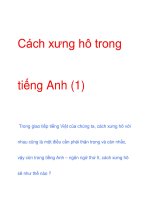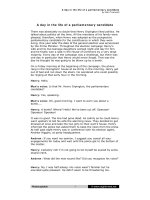Bài luận tiếng anh 1 potx
Bạn đang xem bản rút gọn của tài liệu. Xem và tải ngay bản đầy đủ của tài liệu tại đây (154.77 KB, 11 trang )
Capital Controls and Interest Rate Parity:
Evidences from China, 1999-2004
∗
March 2005
Li-Gang Liu and Ichiro Otani
Abstract
This paper shows that deviations estimated from the uncovered interest rate parity
condition present strong unstationarity and persistency, thus indicating China’s capital
controls is still effective in driving a wedge between onshore and offshore returns.
Similar results are also obtained from covered interest rate parity condition. Our findings
also demonstrate that there is no evidence of money market integration with Hong Kong.
However, the deviation also shows signs of moderation over time because of increased
pace of capital account liberalization.
Key Words: Capital Controls, Interest Rate Parity, Financial Integration
JEL Classification: F31, F36
∗
The authors are senior fellow and international consulting fellow, Research Institute of
Economy, Trade, and Industry, respectively. The paper is prepared for the
RIETI/BIS/BOC Conference on Globalization of Financial Services in China:
Implications for Capital Flows, Supervision, and Monetary Policy” on Saturday 19
th
2005.
The views expressed here are those of the authors alone and do not represent the views of
the institution with which they are affiliated.
1
I. Introduction
Efficacy and effectiveness of capital controls have gained renewed interests after
Malaysia re-imposed controls on capital flows at the height of the 1997-98 Asian
financial crises. The Mundell Trilemma suggest that policy makers can only choose two
out of the three macroeconomic policy objectives; i.e., independent monetary policy;
stable exchange rate, and freedom of capital flows to maintain fundamental policy
consistency. In the Malaysian case, the freedom of capital flows has been sacrificed for
the sake of independent monetary policy and the stable exchange rate. Although the
verdict is still out regarding whether capital controls have facilitated Malaysia’s rapid
recovery from the crisis (IMF, 2000), recent empirical evidences do show that emerging
market economies, because of their lack of credible nominal anchor and their
undeveloped capital markets, often suffered from “the fear of floating” (Calvo and
Reihart, 1998) when they opt to maintain exchange rate stability while pursing free
capital mobility and independent monetary policy.
China has in the past put great emphasis on independent monetary policy and
stable exchange rate at the expense of the freedom of capital flows. However, such
objectives have recently been under increased scrutiny and pressure. Some observers
argue that its undervalued currency was blamed for the economic overheating in 2003-
2004 and its pegged exchange rate regime has been blocking the global adjustment
process in light of the unsustainable current account deficit in the United States
(Goldstein, 2004). Indeed, these assertions implicitly assume that China’s capital controls
have not been effective so that both legal and illegal cross-border capital flows
effectively arbitraged out the interest rate differentials between onshore and offshore,
2
thus making the independent monetary policy objective less obtainable. Some, before
China’s interest rate hike in October 2004, prematurely pointed out that the Chinese
monetary authorities were afraid of raising interest rates to cool the economy because
higher interest rate would attract more capital flows. However, some recent empirical
studies have shown that, despite the onshore and offshore interest rate differentials have
been shrinking over time, China’s capital controls are still effective as these interest rate
differentials still remain large (Ma, Ho, and McCauley, 2004).
Considerable progress has been made in analyzing international capital flows over
the past quarter century when the volume of international capital flows, particularly
private capital movements, increased rapidly, and many industrialized countries removed
capital controls in the 1980s. Frankel (1992) reviewed literature on the analysis of
international capital mobility in the 1970s and 1980s, and concluded that interest rate
parity theory used in a seminal paper by Frenkel and Levich (1977), followed by many
others including Dooley and Isard (1980), Otani and Tiwari (1981), and Frankel (1984
and 1991) among others, is one of the most useful frameworks for quantifying the degree
of capital mobility. According to these studies, deviations from both covered and
uncovered interest rate parity conditions capture transaction costs, including political
risks, exchange rate risk (market pressure), and transaction costs which Frankel (1991)
called “the country premium” that inhibit free mobility of cross-border capital flows. He
also noted that, by quantifying international capital mobility or the lack thereof, one
could examine the extent to which a country’s financial market is integrated with the rest
of the world.









